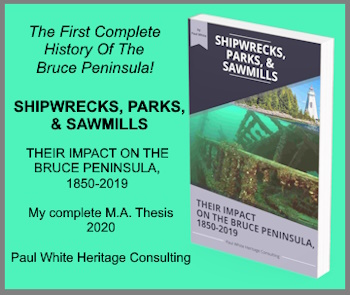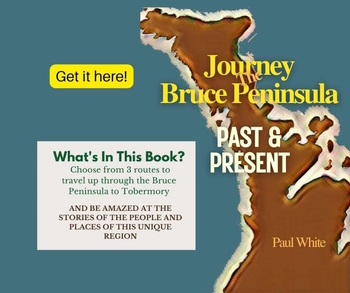Southampton's
Early History
Southampton's early history was a time of identity crisis, and with a connection to an early Arctic mystery story.
The first permanent non-native settlers, Joseph Spence and William Kennedy, did not arrive at Southampton until 1848. However, they were not the first non- native visitors to the area. That region, north to the "Fishing Islands" near the present-day community of Oliphant, was a frequent destination for fishing fleets from the Goderich and Detroit areas. There had also been several visits by fur traders and missionaries to that locale dating back to the earliest dates of French exploration in the region.
Spence and Kennedy had retired from the Hudson Bay Company and taken up residence in the Kingston area. The lure of profits from the fishing industry and trading furs with the natives led them to venture into the Saugeen area. They travelled to Lake Simcoe where they purchased a canoe. They paddled the Severn River to Georgian Bay, and on to Owen Sound. Here they stored their canoe and walked the trail which connected the native villages at Newash and Saugeen. Certain that this region held a prosperous future for them, they returned to Owen Sound, where they purchased supplies, loaded their canoe and paddled to Colpoys Bay where they traversed the portage route to Lake Huron.
Upon their arrival at the mouth of the Saugeen River the two men built a log house on what would one day be Huron Street in Southampton. At the end of the summer, they returned to their Kingston homes. The next year, 1849, they returned and purchased the Goderich-based, Niagara Fish company from 'Tiger' Dunlop and his partners. In 1850 Spence's wife left Kingston to take up permanent residence on the shores of Lake Huron.
Unfortunately, the fishing business was not a successful endeavour for the two men and they parted company. Spence purchased the schooner Sea Gull and began a business sailing from port to port along the Lake Huron shore. Meanwhile, Kennedy began an adventure which would etch his name in the history of Arctic exploration. He became involved in the various attempts to discover the fate of the Franklin expedition.
(Ironically, Franklin and some of his crew had also passed through this area a few years earlier and purchased canoes and supplies from local natives on their way to find the North West passage.)
Soon after Spence and Kennedy had established themselves on the site of Southampton, other settlers moved to the area. Their new neighbours included Alex MacDonald, John Maclean, Joseph Gilbert, Peter Brown, John Cook, James Lambert, and Thomas Lee. Also, among the early pioneers to Southampton were three shopkeepers, Richard Hill, Robert Reed and James Calder.
Not unlike other pioneer settlements, this new community endured many years of identity crisis. Although the town site had been named Southampton by James Price, the Commissioner of Crown Lands, after the British seaport of that name. Perhaps it was Price's hope that one day this Southampton would rival the other as a great port facility. The Department of the Post Office named the postal outlet Saugeen, and the port of entry was called Saugeen. Consequently, the two names were often interchanged causing much confusion, and perhaps consternation for the inhabitants.
In 1890, the name of the post office was changed to Southampton, and five years later the port of entry, the same name ending four decades of name confusion.
Many sources were used to gather the information used in this article. In particular, Pierre Berton's book, The Arctic Grail provided the information about William Kennedy and his quest to find the Franklin Expedition.
A version of this article originally appeared in my Local History column in the February 6, 1998 edition of the Owen Sound Sun Times.
Bruce County History
Bruce County history is rich with stories about the development of communities along the Lake Huron shoreline and shaped by memorable events and the people.
The "Battleship By-Election" was the result of a debate that embroiled all of Canada but was settled in a rural region of southwestern Ontario prior to the First World War.
Bruce Road 3: A Colonization Road linked prospective settlers to undeveloped Crown Lands and a new life.
British Peerage a Source for Township Names. It is interesting to check the origin of the names bestowed on pioneer places such as towns, townships and counties.
Chesley Ontario Welcomes the Krug Brothers who were looking for a place to make their future and their fortune. They were not only successful, but they made significant contributions to the social fabric of their adopted home town.
Billy Crawford: Pioneering Spirit Personified. If you take the time to consider the people you have met during your life you too may know or have known, someone with pioneering spirit just like Billy Crawford.
Frozen Rivers & Lakes can be Hazardous: Icy waterways offer many benefits such as ice fishing, but beware weak, or thin ice is not easily detected and can spell disaster.
Kincardine Ontario's First Settlers using a bit of savvy and some luck created a future for themselves and their families on the Lake Huron shoreline.
The Krug Impact on Chesley Ontario was immense not only in terms of the community's social fabric but with regards to community's economic growth.
Wilfrid Laurier: Despite the town's best efforts to make Wilfrid Laurier's visit a memorable occasion, it would be clouds of dust that would remind the Prime Minister of the Lake Huron community.
Mildmay Ontario overcame competition from other communities to claim its spot in Carrick Township on an important settlement route to the Lake Huron shoreline.
Pioneer Diaries provide Interesting Information about many topics, but sometimes information about the weather can be quite surprising!
The pioneer settlement in Arran Township was completed in 1851. The survey crew had been impressed, by the cheap cost and the potential of the land, that two members of the team, George Gould and Richard Berford, took up plots of land.
Port Elgin Ontario Started with a Storm. A ship forced to seek refuge from Lake Huron's stormy wrath signalled to one man the idea of starting a new community.
Southampton's early history was a time of identity crisis, and with a connection to an early Arctic mystery story.
Southampton Ontario Suffered a Major Fire in 1886: The havoc was created by a furious high wind storm that spread the flames over much of the town.
Tara Ontario's Mill Started the Village Economy and with the entrepreneurial and inventive genius of one man the community prospered!
Walkerton Ontario: The Beginning of this Bruce County town is the result of the drive and determination of one man, Joseph Walker.





